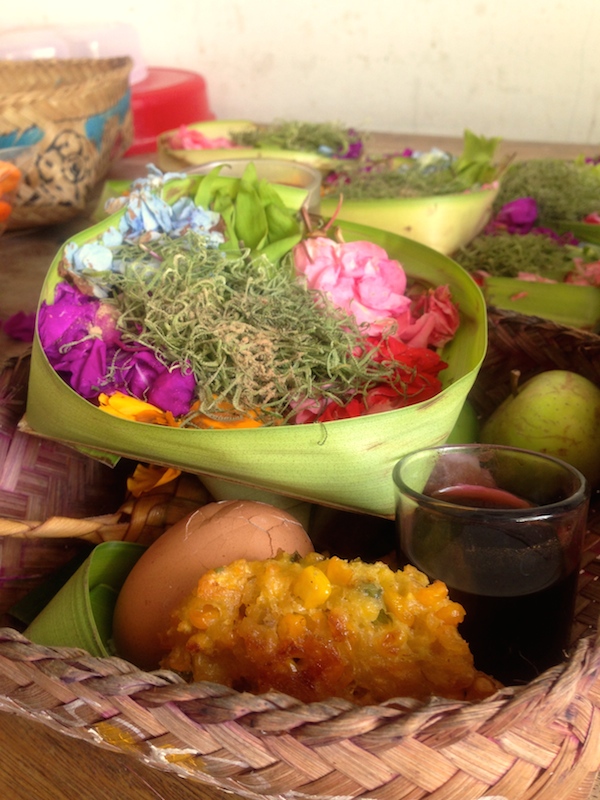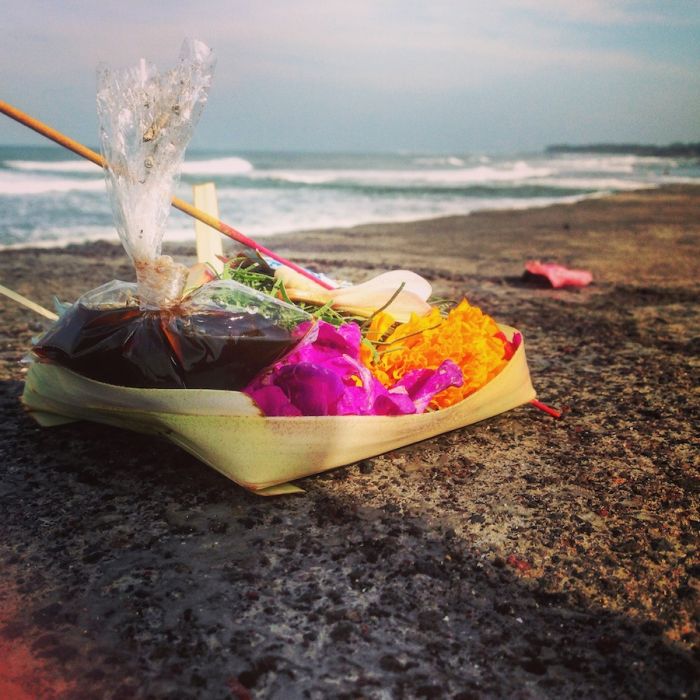Anyone who has been to Bali has seen the little Hindu offerings scattered across the island’s streets. But what many visitors to the Island of the Gods are unaware of is how much these little baskets have been commoditized since Bali’s tourism industry exploded.
It’s a lengthy process that goes into the offerings, called canang sari. Making the basket, creating the gift, and performing the ritual add up to the full dedication given to the gods. A time sacrifice and financial commitment is part of this selfless act.

The base, the canang (pronounced “chan-ang”), is a square woven tray made from coconut leaf, betel nut and lime which represent three Hindu deities: Brahma, Vishnu, and Shiva. Together they form Tri Murti which is the combination of their powers, respectively, as creator, preserver, and fuser.
From east to west and north to south, four different colors of petals fill the basket each symbolizing a relation to a god. At the top of the compass, Vishnu is represented by blue or green, white flowers are given for Iswara and the east, the south, red is for Brahma, and yellow is the color for the western direction and the god Mahadeva.

Traditionally, women would personally hand-make canang sari on a daily basis. That was before the rapid inpour of globalization in Bali.
Noman, a local Balinese lady in her sixties told Coconuts Bali, “I have been making canang sari everyday for years, that’s the traditional way. About ten years ago, nobody bought canang sari. There was no place to buy them. But now there are many women selling [premade] ones.”
Walking down the streets of Bali nowadays it’s as easy to find canang sari vendors as spotting an Indomaret. Over the past few years, the island has gone through major transformations, as if it were featured on Extreme House Makeover – Island Edition (move that bus!).
Bali has become a place where people now have the choice between McDonalds or a warung, mall or market, taxi or uber, or chia seed pudding rather than nasi campur (but we’d still choose nasi).
This culture of consumerism has been overwhelming ever since the rise of tourism on the island. Aussie takeover, much?
As Bali gains more “certificates of excellence” from Tripadvisor, days for locals become busier and time requires efficiency. A quick pit stop at a canang sari street vendor adds an aspect of overall productivity to one’s day.
An Irishman, Derek, working as a pastry chef in Ubud confessed, “my boss would rather pay someone to deliver canang sari to the restaurant rather than paying the employees to personally make them for one hour.” He would bake as he watched his colleagues perform the ritual of presenting the offerings for at least 30 minutes. “My boss wanted to speed up the process so we did not lose time in the kitchen,” Derek added.
The one to two hour time commitment to assemble the offering instead becomes one to two more hours to spend working if buying the offerings off the street.
“When people are busy and working hard, sometimes they don’t have time to make canang sari. It saves people time and gives them more time to work,” Noman said.
Hand-making the offerings is definitely the most time-consuming option, which means buying them is probably not the most financially friendly.
Just a few years ago, “locals could buy five pre-made canang sari for Rp 1k,” Ido, a young Balinese girl, said. We checked the market prices in Canggu, and that same Rp 1k will only buy you one canang sari today. Oh the beauty of capitalism. We got the inside scoop (thanks Ido) on the cheapest deal: the best you may be able to haggle is 15 for Rp 10k.

Whereas once upon time the value of this offering merely extended beyond planet earth, and up to the gods, the worth of canang sari is two-fold today. Not only do these offerings appease the gods, but women are able to generate profit from this religious commodity.
“The ladies don’t make too much by selling them, but it’s another way to bring in money for the family,” Noman shared.
We applaud these female entrepreneurs for capitalizing on the opportunity to sell canang sari.
They are simply supplying what the market has created a demand for (we did not even need a macroeconomics class for that one).
Even if Bali has globalized, the offerings are still routinely interwoven into day-to-day life. Canang sari will continue to cover the streets but the story behind its preparation may take on a whole new meaning. This is what we call globalization (read glo-BALI-zation).




